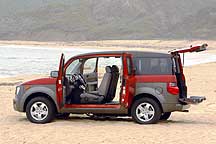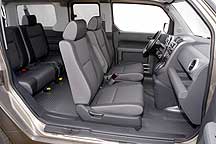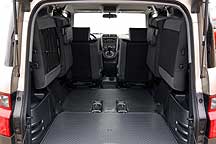
MSRP Range: $ 16,000 to $ 24,000
Invoice Range: $14,500 to $19,500
Price Quote
MSRP As Tested: unknown
Versions: 2-Wheel Drive DX, 4-Wheel Drive DX, 2-Wheel Drive EX, 4-Wheel Drive EX
Vehicle Category: Compact, 5-door, Sport Utility Vehicle (Sport Utility Panel Wagon)
Engine Location: Front Engine
Drive Wheels: Front, 2-Wheel Drive. The 4-Wheel Drive is Full-Time.
Engine As Tested: 2.4-liter, Dual Overhead Cam, Inline 4-Cynlinder, vTec, 160-horsepower at 5,500 rpm with 161 lb-ft of torque at 4,500 rpm
Transmission As Tested: Both the 2-Wheel Drive and the 4-Wheel Drive come with a 5-Speed Manual or an optional 4-Speed Automatic.
Fuel Economy (city/hwy): 2-Wheel Drive with 5-Speed Manual - 21/23, 22-Wheel Drive with 4-Speed Automatic: 21/25, 4-Wheel Drive with 5-Speed - 20/23, 4-Wheel Drive with 4-Speed Automatic - 20/24
Standard Safety Features: Driver and Front Passenger, front airbags, 4-wheel disc brakes.
Competition: 2003 Chrysler PT Cruiser, Ford Escape, Honda CR-V, Jeep Liberty, Mazda Tribute, Nissan Xterra, Pontiac Vibe, Subaru Forester, Suzuki Aerio, Toyota Matrix
DETROIT, Mich. -- Only a quick glance at Honda's new cubistic crate on wheels will tell you this isn't another tot-toting sport-utility vehicle.
True, it stands rather tall in a boxy format like any other SUV and there are four rounds of rubber on the ground as well as a pair of doors on each flat flank for access to the passenger compartment, plus a cargo gate at the tail.
But, it's so flat, so angular, so squared.
And there are all of those chip-resistant composite panels. They're flared in arching rings around the wheelwells, squared in caps across the front corners and wrapped over top rear quarters.
This thing looks like it came out of a design school for armored personnel carriers or UPS delivery vehicles, yet the automotive stylists at American Honda proclaim the new vehicle as must-have transportation for the college crowd and sand-and-surf or snowboarder and X-sport sets.

You can call it the Element, as in elementary.
Best described as a mobile dorm room, it's a basic vehicle with a cavernous wash-and-wear cabin that's flexible and convertible in a design that accommodates up to four riders and all sorts of packed gear.
On those flat sides, check out the double doors: Front one's hinged at the front but the adjoining rear door has hinges on the tail side and both doors open wide in suicide-door fashion to forge a broad pillar-less opening on each side for stuffing gear aboard -- trail bikes, snowboards, maybe even a sofa and stereo speakers to outfit that dorm room.
Then at the rear the hatch door consists of top and bottom sections that swing open like a clam's shell -- the lower lid folds down flat in line with the cargo floor as a seat or loading dock while the top one swings up until it's horizontal with the roof. It shelters the bay when up and creates an opening as wide and tall as the cargo bay.

Inside, the flat floor of Element is covered by a hard urethane-coated surface that sweeps out and wipes down fast.
Likewise, the four flip-and-fold seats in the cabin are also designed for quick cleaning. Front buckets are clad in a feel-good fabric that's actually waterproof while two back seats wear durable vinyl upholstery.
Layout consists of a pair of firm bucket-style seats in front and followed by two broader buckets set side-by-side in a second row.
Seatbacks for the front set fold rearward until flat, as do both seatbacks on the second row. In effect, with all seatbacks folded down you end up with two long rows that resemble cots or sleeper seats.

And the back seats perform other tricks: Seatbacks also fold forward until flat, then each seat has a hinge on its outboard flank so the entire seat flips up to rest in vertical stance out of the way against the cabin wall. Or each seat pod may be removed entirely -- they're light in weight and easy to eliminate.
This clears the bay for stuffing aboard big loads.
Dimensions of the bay -- 70 cubic feet with the rear seats flipped against the wall or almost 75 cubic feet with the pair removed -- open Element to haul a diverse collection of cargo.
A pair of mountain bikes fit easily, and without needing to remove the front wheels or handlebars. A pair of snowboards also fit, and the wagon even accommodates long items like a ten-foot surfboard -- with cargo doors shut. A couch for the dorm or a big recliner chair? Even these bulky items may squeeze inside Element.
Honda's designers, led by Eric Schumaker, executive design manager at Honda R&D Americas, equate the concept of Element with a California lifeguard station -- a shack on stilts like the ones on "Baywatch" TV shows. It's a small but livable space, carefree but cleanable with a broom or sponge, secure and lockable, but quite simple in design, scale and concept.
The variation for Element is that a set of wheels have been added, plus the locomotion mechanisms of a sturdy sport-utility vehicle rigged with a thrifty but strong four-pack powerplant.
Foundation for Element traces to Honda's Global Compact Platform also employed for the CR-V sport-utility, only the wheelbase has been abbreviated by a couple of inches as the wheel track is expanded. The unit-body platform merges chassis and superstructure to forge a single framework that's extremely strong and rigid, with extra bracing applied in the area of pillar-less side portals where the double doors go.
The CR-V suspension -- MacPherson struts up front with toe control linkage and a reactive double wishbone design in the rear -- was also applied, but with a more compact rear damper and spring assembly installed and the geometry modified by lowering contact points for links in order to drop the equipment and make room for a flat cabin floor.
In addition, larger wheels and tires go to Element, with 16-inch rollers capped by P215/70R16 99S Goodyear Wrangler HP tires. Silver-painted steel wheels are standard, but silver alloy wheels come with the up-level trim.
Steering is a rack and pinion system that translates to quick responses and makes an extremely tight turning radius of 34 feet. The power steering box adds internal dampening valves designed to reduce steering kickback when crossing potholes and pavement bumps.
Brakes show a disc at every wheel, vented in front and solid in back. The top trim adds an anti-lock brake system (ABS) with electronic brake force distribution (EBD).
For locomotion, Element carries the CR-V engine, a twin-cam 2.4-liter in-line-four with aluminum block and heads and Honda's new i-VTEC variable timing valvetrain. It delivers a robust 160-hp at 5500 rpm with 161 lb-ft of torque at 4,500 rpm.
It works with either the standard manual five-speed or optional automatic four-speed transaxle for the front-wheel-drive (FWD) version or one with Honda's intelligent four-wheel-drive (4WD) device permanently engaged to direct the engine's muscle to all wheels.
As a bonus added to the 4WD Element, a large skylight in the cargo bay tilts up or pops out entirely.
Two levels of trim work on Element -- DX and EX.
Element DX contains significant equipment including power controls for windows and door locks but EX models get more gear including air conditioning, cruise control and a high-powered stereo sound kit with auxiliary jack for connecting external audio components like a digital MP3 player.




